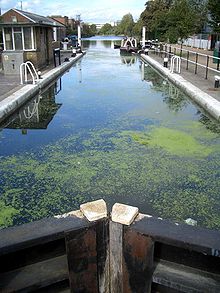- Old Ford
-
Coordinates: 51°32′02″N 0°02′00″W / 51.53391°N 0.03341°W
Old Ford is an area in the London Borough of Tower Hamlets and traditionally considered part of Bow.
Contents
History
Administration and boundaries
Historically, Old Ford was a cluster of houses and a mill, around the location of the ford. It formed a part of the medieval parish of Stepney, with a rising population in the Victorian era, it did become an independent parish, but civil administration has always been associated with Bow.
Old Ford
Old Ford, as the name suggests, was the ancient most downstream crossing point of the River Lea. This was part of a pre-Roman route that followed the modern Oxford Street, Old Street, through Bethnal Green to Old Ford and thence across a causeway through the marshes known as Wanstead Slip (actually in Leyton). The route then continued through Essex to Colchester. At this time the Lea was a wide fast flowing river and the tidal estuary stretched as far as Hackney Wick.[1]
Colchester[2] was where the Romans set up their initial capital for their occupation, and the road was upgraded to run from the area of London Bridge as one of the first paved Roman roads in Britain. Evidence has been found of a late Roman settlement at Old Ford dating from the 4th and 5th centuries. Excavations in 2002–3 discovered a substantial 'ribbon' development along the line of the road, surrounded by fields. Near the river there was evidence for a cluster of wooden buildings dominated by a large open-ended barn. Large amounts of cattle bone were also discovered, suggesting butchery to supply the London market. The Lea was thought to be used to supply Roman London with agricultural products and pottery from Hertsfordhire and the north. Old Ford was where the goods were transferred to continue their journey into London by wagon.[3]
In 1110, Matilda, wife of Henry I, reputedly took a tumble at the ford on her way to Barking Abbey and ordered a distinctively bow-shaped three-arched bridge to be built over the River Lea, The like of which had not been seen before. The building of the bridge at Bow didn't leave Old Ford as a backwater and the ford continued to be well used, but it was in an isolated and rural area and the local population centre moved to Bow in the middle ages. Old Ford was one of the sites of one of the many water mills in the area that supplied flour to the bakers of Stratforde-atte-Bow, and hence bread to the City. Due to their isolation residents were given dispensation to worship in the chapel of ease at Stratforde-atte-Bow, later Bow Church, to save the often difficult journey to the parish church of St Dunstan's at Stepney.
A lock and weir now exist on the Lee Navigation near where the ford used to be. This lies at the end of 'Hackney Cut', an 18th century artificial channel and the natural channel (known as the Waterworks River) rejoins the channel below the lock.
Victorian era
Farming and market gardening prevailed in the district until the 19th century when Old Ford became a part of the seamless East End conurbation, with large estates of relatively poor houses and much poverty. These were built to serve the new factories on the Lea and Lee Navigation and to serve the new railways.
Railways
The North London Railway had a line through the area with a station at Old Ford railway station. The line was badly damaged during World War II and never reopened. The station buildings were demolished in the early 1960s.
Today
As of 2010 the Old Ford is again becoming desirable because of its streets of Victorian housing and improved transport links. The coming of the London 2012 Olympics is expected to provide an impetus to regeneration of the area.
The railway line is expected to reopen as a part of the Crossrail project but no additional stations are planned to serve the area.
References
- ^ 'Bethnal Green: Communications', A History of the County of Middlesex: Volume 11: Stepney, Bethnal Green (1998), pp. 88-90 accessed: 15 November 2006
- ^ Celtic : Camulodunon, Roman : Camulodunum derived from Camulus, a Celtic God of War
- ^ Mapping the sub-surface drift geology of Greater London gravel extraction areas (MOLAS report for English Heritage 2002/3) accessed 28 March 2008
Local council
Communal facilities
Local council facilities are grouped around Roman Road market. The local library, now called an Idea Store, is situated in Gladstone Place. A community and tenants' hall is nearby. Access to council services is dealt with by the Bow and North Poplar One Stop Shop in Ewart Place.
Education
Nearby places
The nearest London Overground station is Hackney Wick
The nearest Docklands Light Railway station is Pudding Mill Lane. (Stratford)
To the south, the nearest London Underground station is Bromley-by-Bow on the District Line.
Access to the Hertford Union Canal is via the tow-path from Wick Road at St Marks Gate (Victoria Park). East leads to the Lee Navigation where proceeding north leads to Hackney Marshes. As this latter is within the Olympic Park the tow-path may be closed unpredictably while building works are undertaken. Turning south along the Lea leads through Bow Locks, into Bow Creek and thence to the River Thames, but the tow-path can also often be blocked. West from Wick Road leads to the Hertford Union junction where the canal joins the Regent's Canal, near Mile End.
See also
- A number of artificial waterways cross the district. Old Ford Lock could refer to:
- On the Lee Navigation, to the east of the district
-
- On the Regent's Canal, to the west of Victoria Park
-
- On the Hertford Union Canal, to the south of Victoria Park
Categories:- Districts of Tower Hamlets
- Districts of London
Wikimedia Foundation. 2010.



